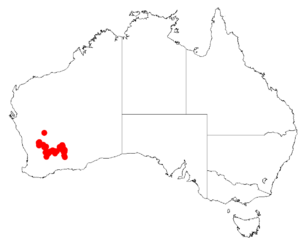Acacia consanguinea facts for kids
Quick facts for kids Acacia consanguinea |
|
|---|---|
| Scientific classification | |
| Genus: |
Acacia
|
| Species: |
consanguinea
|
 |
|
| Occurrence data from AVH | |
Acacia consanguinea is a type of shrub that belongs to the Acacia family, also known as wattles. It's a special plant because it's endemic to a specific part of Western Australia, meaning it's only found there naturally.
Contents
What Does Acacia consanguinea Look Like?
This shrub often spreads out and looks a bit like a broom. It usually grows to be about 0.4 to 1.5 metres (1 to 5 ft) tall. Its branches are a greyish color, like ash. They are round and smooth, without any noticeable ridges.
Leaves and Flowers
Like many Acacia plants, it doesn't have regular leaves. Instead, it has what are called phyllodes. These are flattened leaf stems that act like leaves. The phyllodes of Acacia consanguinea stand upright and are always green. They can be straight or slightly curved. Each one is about 2 to 7 cm (0.79 to 2.76 in) long and 1 to 1.5 mm (0.039 to 0.059 in) wide. They have eight faint lines, or "nerves," running along them. This shrub blooms with bright yellow flowers from August to September.
Where Does Acacia consanguinea Grow?
This plant is found naturally in the south-western part of Australia. You can see it in the Goldfields-Esperance and Wheatbelt regions of Western Australia. It often grows on low hills and flat areas. It prefers sandy soils that have some gravel mixed in.
Specific Locations
The area where this shrub grows stretches from around Muntadgin in the west. It goes as far east as Coolgardie. There's also at least one group of these plants found much further north, near Wialki. Acacia consanguinea is usually part of scrub or heath plant communities in these areas.
How Is It Classified?
In the world of plants, Acacia consanguinea belongs to the Acacia fragilis group. This means it is closely related to other Acacia species like A. fragilis and A. uncinella.

